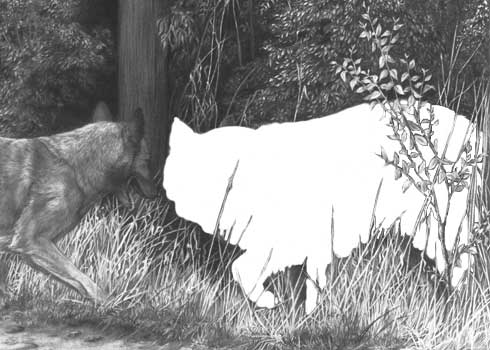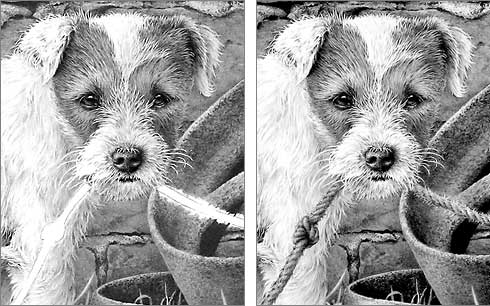Negative drawing involves the creation of a element within your drawing by simply drawing around it. If, for example, you’re drawing a dog, it is often logical to draw the background first. This presents two benefits: you have an established setting in which you dog can live, so they will possess a unity; and you have full control over the dominance of the dog (the way it stands out, or blends in, to the background).
Logic plays a major role in this way of working. Let’s take our dog again. Because it is the main element, the focus of the drawing, we have a natural inclination to work on that first. But how light or dark should it be? Where is the light source positioned, and what sources of reflected light are present?
Now turn the strategy on its head. Consider drawing the secondary elements first. You should have a mental picture of what you want to achieve with the dog so, keeping that in mind, we have a logical starting point for the background. With the background completed we now have a setting in which our white silhouette of a dog exists. We have a feel for its environment. We know if the ambient lighting is harsh or diffused. We know what might overlap it, such as stems of grass or weeds, and how they fit naturally into the overall setting. So we now have full control over the separation of the subject from the background.
Let’s take one small area – the junction of the dog’s coat along its back with the background. If you draw the dog first, how dark do those hairs along the extremity need to be? Draw the background first, and draw around those hairs along its back and you have all the control you need. As you gently add tone and form to those hairs, you have the background to refer to at all times.
That single example has covered the three major benefits of using Negative drawing:
- Offers control by separating the background, midground and foreground elements.
- Isolates the unknown.
- Protects virgin whites.

Taken to extremes but this is a recreation of an actual event.

If those are the ‘rules’ then logic overrules them. In practice you draw until understanding ceases then you move to another area you do understand. As you draw, each area will suggest the treatment of the content of those surrounding it. Eventually, your drawing will expand to meet that unknown area. Now surrounded by enlightened drawing, you will gain a greater understanding of what that area requires. So, when I mentioned “completing the background first” that is not necessarily to be taken as the full truth! In reality I will work the background in stages around the dog, and I may (though not often) draw the adjoining portion of the dog too, but the order is always background first then dog.
DRAWING WITH UNDERSTANDING
To draw effectively, you must fully understand the area you are working on. You must be able to experience it in three-dimensions, to feel its texture, and to know how it relates to surrounding areas. We’re not copying source photos but creating our own world in which all elements must co-exist. If you have first established the background, the environment, then you have a world in which you can create your main subject. This assists your understanding of the subject as an overall element.
However, within that element other similar problems will occur, which can be solved using the same strategy. Perhaps you have a problem understanding the way the rear of the belly and rib cage meet the shoulder of the rear leg? Leave it. Draw the rear leg first and understanding will be clarified, so you can confidently draw the belly up to that previously ‘unknown’ junction.
In the meantime, you haven’t polluted the virgin white of that belly area with trials and test of possible tones. In my opinion the freshest, sharpest and most effective drawing is created with the first attempt. If instead you try out ideas within that area, perhaps by adding layers of tone in an attempt to understand the shaping, you will simply muddy the final result. Consider that a soft grade of graphite often will not layer to its full potential on top of a harder grade, because there is insufficient tooth to hold it, and you’ll see that your initial trials have greatly reduced the options open to you.

Keeping control of the drawing of the rope by establishing the background first